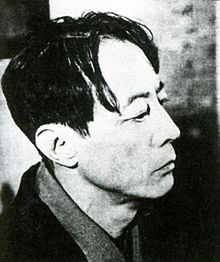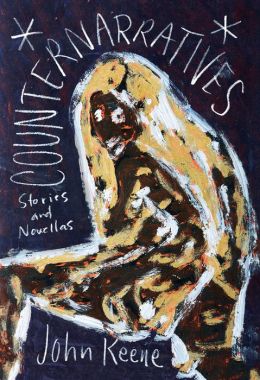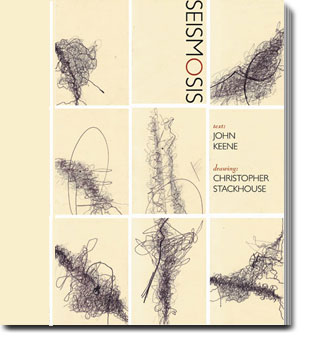 |
| Shuzo Takiguchi (Mirador. Blog de Joan Miró, Cultural y Arte, por Antonio Boix.) |
"René Magritte," once you read it, is an open tribute to the great, popular Belgian Surrealist, who lived from 1898 to 1967, and who produced some of the most iconic art work of the Surrealist movement--though he broke with André Breton over his decision to stay in Brussels instead of returning to Paris before the war. Allusions to various recurring Magrittean images, such as silhouettes, water, mountains, and hats appear, but it is not just the imagery, but the incantatory repetition of phrases, privileging sound and juxtaposition over clarity and immediacy of meaning, the unmooring of realist logic, that also underpins Takiguchi's own Surrealist poetic practice, and the way he translates his understanding of Magritte into poetry. His translation is not literal, but imaginative and contextual. Additionally, the end words, when read aloud, almost make the two stanzas feel like the opening or ending to a sestina, though it clearly isn't one.
So was there a particular Magritte painting or were there paintings that Takiguchi had in mind? He mentions "silhouettes / flow incessantly like water," as well as "a mirror trick, / like a human echo / burns a silk hat endlessly." Given these references, two Magritte paintings, "La Belle Société" (1962) and "Décalcomania" (1966) come to mind. In both there are human silhouettes that open up, like windows, onto beach landscapes with water flowing in the distance. As it turns out, Takiguchi created his own set of decalcomanic artworks, keeping the media as the title. The final stanza seems to refer to the two paintings above as well as to another famous Magritte image, "The Masterpiece Or the Mysteries of the Horizon," featuring three men, angled in various ways away from the viewer, and three crescent moons that could also be eclipses. (The poem could also be titled "Giorgio de Chirico" given the landscapes Takiguchi describes and paints.)
Yet what I want to argue is that even if Takiguchi had these two paintings, or just the latter one, in mind, his poem's language and imagery capture the spirit of Magritte such that any painting could stand in. His approach stands against literalness in favor of something more elusive and strange, not unlike Magritte's often very beautiful and bizarre paintings. Here I quote from Mary Jo Bang's and Yuki Tanaka's "Translators' Note," which shares a bit more information about what Takiguchi was after:
With Takiguchi, the surrealist estrangement has to be maintained in today’s poetic world where defamiliarization is not as surprising as it once was. To that end, we have had to be careful not to normalize the poems or alter their dialogic relationship to French surrealism. Takiguchi was actively involved in that literary movement. He corresponded with André Breton and translated his 1928 Surrealism and Painting into Japanese two years after it was published in France. An Abridged Dictionary of Surrealism, compiled by Breton and Paul Éluard for the International Surrealism Exhibition in 1938, recognized Takiguchi as a “poète et écrivain surréaliste.” The present poems were first published in 1936 in L’échange surréaliste, a collection of writings and drawings by European Surrealists in Japanese translation, designed to foster international exchange. Takiguchi also helped revive the avant-garde scene in postwar Japan by spearheading an interdisciplinary art group called Jikken Kobo (Experimental Workshop), which was active from 1951 to 1957. The experimental fervor of French surrealism can be felt in the radical texture of Takiguchi’s poems and his decision to call them “poetic experiments.”
You can find more about Takiguchi here. There's also his archives, where you can view some of his drawings.
And now, the poem.
***
RENÉ MAGRITTE
by Shuzo Takiguchi
Translated by Mary Jo Bang and Yuki Tanaka
Released silhouettes
flow incessantly like water,
flow between mountains
swiftly like a kaleidoscope.
The solitude of the North Pole
bustles with human silhouettes.
Endless transmission of ABC.
On the shredded shore
a silk hat burns
like a mirror trick,
like a human echo
burns a silk hat endlessly.
Then the flames
were received like ABC.
On the night of a beautiful lunar eclipse
the silhouettes smiled.
Translated from the Japanese
Translators’ Note: Three Poems by Shuzo Takiguchi
Here are the three paintings by René Magritte, followed by one of Takiguchi's "Decalcomania" series:
 |
| René Magritte, The Beautiful Society, oil on canvas, 1962. |
 |
| René Magritte, Decalcomania, oil on canvas, 1966. |
 |
| René Magritte, The Masterpiece or Mysteries of the Horizon, oil on canvas, 1955, private collection. |
 |
| Shuzo Takiguchi, Spirit of Matthias Grunewald, decalcomanic painting on paper, 1962. |









